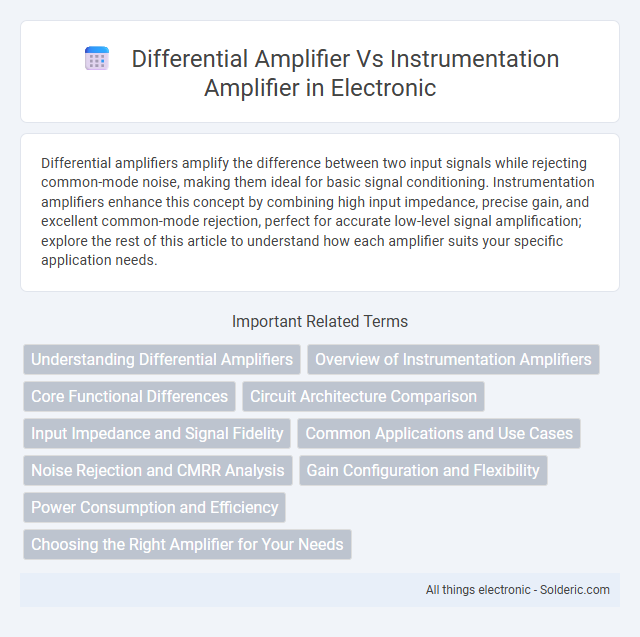Differential amplifiers amplify the difference between two input signals while rejecting common-mode noise, making them ideal for basic signal conditioning. Instrumentation amplifiers enhance this concept by combining high input impedance, precise gain, and excellent common-mode rejection, perfect for accurate low-level signal amplification; explore the rest of this article to understand how each amplifier suits your specific application needs.
Comparison Table
| Feature | Differential Amplifier | Instrumentation Amplifier |
|---|---|---|
| Purpose | Amplifies the voltage difference between two inputs | Precisely amplifies small differential signals with high accuracy |
| Input Impedance | Low to moderate input impedance | Very high input impedance (ideal for sensor inputs) |
| Gain Accuracy | Gain can vary; fixed by resistor matching | High gain accuracy; gain set by a single resistor |
| Common-Mode Rejection Ratio (CMRR) | Moderate CMRR depending on design | Very high CMRR, ideal for noise rejection |
| Complexity | Simple two-op-amp or one-op-amp design | More complex, usually three-op-amp configuration |
| Applications | Basic differential signal amplification | Medical instrumentation, sensor signal conditioning |
Understanding Differential Amplifiers
Differential amplifiers amplify the voltage difference between two input signals while rejecting common-mode noise, making them essential in precision measurement applications. They typically consist of bipolar junction transistors or operational amplifiers arranged to maximize gain for the differential input and minimize output due to common signals. Key parameters include high common-mode rejection ratio (CMRR), input impedance, and gain accuracy, distinguishing them from instrumentation amplifiers which build upon differential amplifiers with additional buffering and gain stages for improved performance in demanding environments.
Overview of Instrumentation Amplifiers
Instrumentation amplifiers provide high input impedance, low noise, and precise gain control, making them ideal for amplifying low-level differential signals in noisy environments. Unlike basic differential amplifiers, instrumentation amplifiers consist of multiple op-amps configured to minimize input bias current and improve common-mode rejection ratio (CMRR). Their design allows accurate amplification of small sensor signals, widely used in medical devices, industrial process controls, and data acquisition systems.
Core Functional Differences
A differential amplifier amplifies the voltage difference between two input signals but typically lacks high input impedance and precise gain stability. An instrumentation amplifier enhances this by incorporating buffer amplifiers and precise gain control resistors, providing high input impedance, excellent common-mode rejection ratio (CMRR), and stable gain. Your choice depends on whether you require simple signal difference amplification or precise, low-noise measurement in environments with significant interference.
Circuit Architecture Comparison
A differential amplifier features a simple two-transistor design that amplifies the voltage difference between its two input signals but offers limited input impedance and common-mode rejection. Instrumentation amplifiers use a multi-stage architecture with input buffer amplifiers and a differential amplifier stage, providing high input impedance, precise gain control, and superior common-mode noise rejection. Your choice between these architectures depends on the required signal fidelity, noise immunity, and application precision.
Input Impedance and Signal Fidelity
Differential amplifiers typically have moderate input impedance, which might limit signal fidelity when dealing with high-impedance sources, whereas instrumentation amplifiers are designed with very high input impedance to minimize signal loading and preserve accuracy. Your choice should consider that instrumentation amplifiers offer superior signal fidelity through enhanced common-mode rejection and minimal distortion, making them ideal for precise, low-level signal measurements. Optimizing input impedance and signal fidelity ensures the reliability of sensitive data acquisition systems.
Common Applications and Use Cases
Differential amplifiers are widely used in audio equipment, sensor signal conditioning, and operational amplifier circuits to amplify the difference between two input signals while rejecting common-mode noise. Instrumentation amplifiers excel in precise and low-level signal amplification applications such as medical instrumentation, industrial process controls, and data acquisition systems due to their high input impedance and excellent noise rejection. Your choice depends on the required accuracy, input impedance, and noise rejection, with instrumentation amplifiers favored for high-precision and low-noise environments.
Noise Rejection and CMRR Analysis
Differential amplifiers provide basic noise rejection by amplifying the voltage difference between two inputs while rejecting common-mode signals, but their Common-Mode Rejection Ratio (CMRR) is typically lower compared to instrumentation amplifiers. Instrumentation amplifiers are engineered with multiple amplification stages and precision resistor matching, resulting in significantly higher CMRR, often exceeding 100 dB, which enhances noise rejection in low-level signal environments. Your choice of amplifier impacts measurement accuracy, especially in applications requiring precise signal extraction from noisy sources.
Gain Configuration and Flexibility
Instrumentation amplifiers offer precise and stable gain configuration through external resistors, enabling fine-tuning and high input impedance ideal for sensitive sensor applications. Differential amplifiers typically have fixed gain determined by resistor ratios directly on the circuit, offering less flexibility but simpler design in low-noise environments. The instrumentation amplifier's three-op-amp topology ensures enhanced common-mode rejection and adaptability, making it superior for complex signal conditioning tasks.
Power Consumption and Efficiency
Differential amplifiers typically consume less power due to their simpler design, making them efficient for basic signal amplification tasks. Instrumentation amplifiers, designed for high precision and input impedance, often have higher power consumption because of their multiple op-amps and additional circuit components. Efficiency in instrumentation amplifiers is optimized for accuracy and noise rejection rather than minimal power use, distinguishing them from traditional differential amplifiers.
Choosing the Right Amplifier for Your Needs
Differential amplifiers excel in applications requiring basic voltage difference measurement with moderate accuracy, offering simplicity and low power consumption. Instrumentation amplifiers provide superior precision, high input impedance, and excellent noise rejection, making them ideal for medical sensors, strain gauges, and low-level signal amplification. Selecting the right amplifier depends on balancing factors like input signal quality, required gain accuracy, and environmental noise conditions.
differential amplifier vs instrumentation amplifier Infographic

 solderic.com
solderic.com